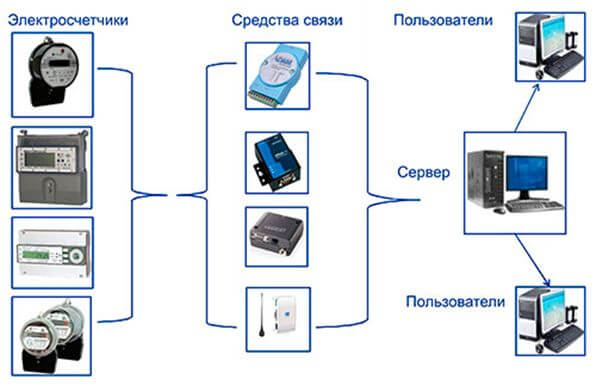What is the ASTUE system?
Appointment
The purpose of the system can be represented as follows:
- measurement of consumed electricity in metering stations included in the system;
- transmission of measurement results via communication channels to a central server;
- storage of information and authorized access to it by users of the system;
- consumption analysis using special application programs (AWP) included in the complex.
ASTUE structure
Below is a general diagram that will help to understand how ASTME works and what it is.
The figure shows that the system contains several levels of hierarchy. The lower level includes measuring instruments located in metering stations. These include meters and measuring transformers. The average level consists of devices that collect and transmit data (USPD), and communications (modems, radio stations). The upper level of ASTUE is server hardware and software related to users' workstations most often over a local network.
Principle of operation
Meters are recorded in the system synchronously, at intervals determined by the program. The accounting data of each time slice through the communication devices is sent to the server, where they are stored in a specific format. ASTUE uses smart meters equipped with memory units and interfaces for data transmission. Some types of meters have built-in modems and can independently, at a specified time, transmit readings to the server using a telephone line, GSM network or radio channel. For successful operation, all intelligent system components must be time synchronized.
The automated system of technical accounting of electricity allows you to:
- real-time monitoring of power consumption of individual structural groups of production;
- analysis of the structure of electricity consumption by units, identification of wasteful use of energy resources;
- the use of data obtained from ASTUE for the development of energy-saving policies.
Difference from ASKUE
Automated system of commercial electricity metering (decryption ASKUE) has the same hierarchy structure as ASTUE, the principle of operation and is implemented using the same technical means. The main differences between the systems are as follows:
- The structure of ASKUE includes only commercial meters, that is, those according to the testimony of which payment is made for electricity consumed. In ASTUE metering points are determined on the basis of the convenience of analysis of electricity consumption.
- Data from ASKUE transmitted to the server of the network company serve as the basis for invoicing for payment. ASTUE data is a product for domestic consumption for the purpose of analysis.
- ASKUE are required to have all wholesale consumers of electricity in accordance with applicable law. ASTUE is established by decision of an economic entity to solve internal problems.
Thus, the difference between the two systems determines their final destination.
Features AWP users
Specialized software, including a set of applied programs “workstation of power engineering” allows for a detailed analysis of electricity consumption both in the enterprise as a whole and in each division or process chain separately.
The principle of operation of applied programs makes it possible to build a variety of schedules that clearly demonstrate the power consumption of individual technological units by the day, to form real daily consumption schedules of both the enterprise as a whole and any of its units separately. This allows you to make real forecasts of the use of electricity, which will help to plan the financial activities of the enterprise, as well as submit reasonable requests for electricity consumption for future periods.
ASTUE data may turn out to be indispensable in determining the norms of electric energy consumption per unit of output, or for any closed technological cycle. The need for such calculations very often arises in the implementation of financial analysis of the enterprise.
Conclusion
The aforementioned shows that an automated system of technical accounting of electricity can serve as a powerful tool for developing and implementing energy conservation policies, which, when used correctly, opens up great opportunities.
It should be emphasized that the introduction of ASTAE alone does not bring energy savings. The purpose and principle of the complex is to provide opportunities for analysis and development of measures to save energy.
Despite the fact that the implementation of this system does not apply to cheap events, the benefits received from the implementation of the developed programs for saving electric energy and optimizing the operating modes of electrical equipment will make it possible to recoup the costs.
So we examined the principle of operation of the ASTUE, the purpose and structure of the system. We hope the information provided was useful and interesting for you!
It will be useful to read:








